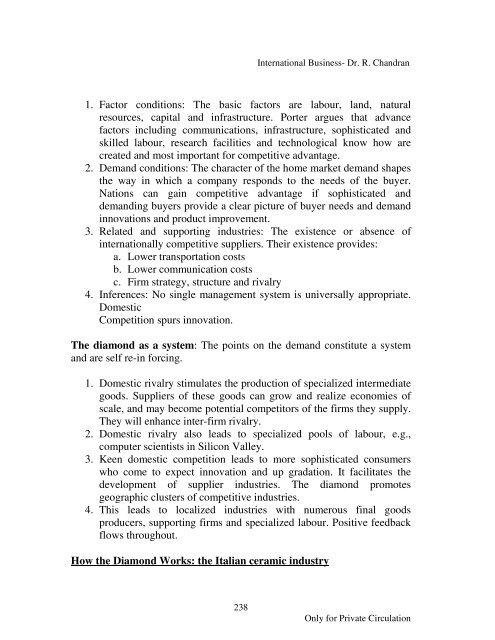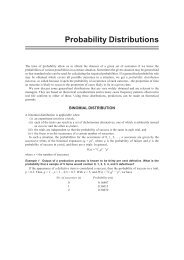- Page 1 and 2:
1 International Business- Dr. R. Ch
- Page 3 and 4:
COMPANY COUNTRY OF ORIGIN REFORM PR
- Page 5 and 6:
5 International Business- Dr. R. Ch
- Page 7 and 8:
7 International Business- Dr. R. Ch
- Page 9 and 10:
4. Diplomatic relations 9 Internati
- Page 11 and 12:
11 International Business- Dr. R. C
- Page 13 and 14:
10. Legal aspects 11. Investment an
- Page 15 and 16:
15 International Business- Dr. R. C
- Page 17 and 18:
17 International Business- Dr. R. C
- Page 19 and 20:
LICENSOR LICENSEE PROVIDE THE RIGHT
- Page 21 and 22:
Supply International Business- Dr.
- Page 23 and 24:
23 International Business- Dr. R. C
- Page 25 and 26:
10. MERGERS AND ACQISITIONS 25 Inte
- Page 27 and 28:
12. TURNKEY PROJECTS 27 Internation
- Page 29 and 30:
13. COUNTER TRADE 29 International
- Page 31 and 32:
31 International Business- Dr. R. C
- Page 33 and 34:
33 International Business- Dr. R. C
- Page 35 and 36:
a) Home country Economy 35 Internat
- Page 37 and 38:
37 International Business- Dr. R. C
- Page 39 and 40:
SOCIAL ENVIRONMENT 39 International
- Page 41 and 42:
41 International Business- Dr. R. C
- Page 43 and 44:
43 International Business- Dr. R. C
- Page 45 and 46:
45 International Business- Dr. R. C
- Page 47 and 48:
47 International Business- Dr. R. C
- Page 49 and 50:
49 International Business- Dr. R. C
- Page 51 and 52:
1. POLITICAL RISKS 2. ECONOMIC RISK
- Page 53 and 54:
53 International Business- Dr. R. C
- Page 55 and 56:
55 International Business- Dr. R. C
- Page 57 and 58:
57 International Business- Dr. R. C
- Page 59 and 60:
59 International Business- Dr. R. C
- Page 61 and 62:
FDI Policy Initiatives 61 Internati
- Page 63 and 64:
63 International Business- Dr. R. C
- Page 65 and 66:
65 International Business- Dr. R. C
- Page 67 and 68:
67 International Business- Dr. R. C
- Page 69 and 70:
69 International Business- Dr. R. C
- Page 71 and 72:
71 International Business- Dr. R. C
- Page 73 and 74:
73 International Business- Dr. R. C
- Page 75 and 76:
75 International Business- Dr. R. C
- Page 77 and 78:
Bahrain international Business Cent
- Page 79 and 80:
(ACUs). These are operational units
- Page 81 and 82:
6. Essentials of Trade Finance 81 I
- Page 83 and 84:
83 International Business- Dr. R. C
- Page 85 and 86:
RATES TT Selling Rate Exchange Marg
- Page 87 and 88:
87 International Business- Dr. R. C
- Page 89 and 90:
89 International Business- Dr. R. C
- Page 91 and 92:
91 International Business- Dr. R. C
- Page 93 and 94:
93 International Business- Dr. R. C
- Page 95 and 96:
95 International Business- Dr. R. C
- Page 97 and 98:
97 International Business- Dr. R. C
- Page 99 and 100:
99 International Business- Dr. R. C
- Page 101 and 102:
101 International Business- Dr. R.
- Page 103 and 104:
103 International Business- Dr. R.
- Page 105 and 106:
105 International Business- Dr. R.
- Page 107 and 108:
107 International Business- Dr. R.
- Page 109 and 110:
109 International Business- Dr. R.
- Page 111 and 112:
111 International Business- Dr. R.
- Page 113 and 114:
) Constant motivation of subsidiari
- Page 115 and 116:
115 International Business- Dr. R.
- Page 117 and 118:
117 International Business- Dr. R.
- Page 119 and 120:
2. Organizations with an Internatio
- Page 121 and 122:
3.3 Organization according to Geogr
- Page 123 and 124:
123 International Business- Dr. R.
- Page 125 and 126:
125 International Business- Dr. R.
- Page 127 and 128:
127 International Business- Dr. R.
- Page 129 and 130:
129 International Business- Dr. R.
- Page 131 and 132:
131 International Business- Dr. R.
- Page 133 and 134:
133 International Business- Dr. R.
- Page 135 and 136:
Joint Venture with an Indian Partne
- Page 137 and 138:
137 International Business- Dr. R.
- Page 139 and 140:
139 International Business- Dr. R.
- Page 141 and 142:
141 International Business- Dr. R.
- Page 143 and 144:
143 International Business- Dr. R.
- Page 145 and 146:
145 International Business- Dr. R.
- Page 147 and 148:
147 International Business- Dr. R.
- Page 149 and 150:
149 International Business- Dr. R.
- Page 151 and 152:
Stage:6 “Global mindset, customer
- Page 153 and 154:
153 International Business- Dr. R.
- Page 155 and 156:
The Decision Making Process 155 Int
- Page 157 and 158:
157 International Business- Dr. R.
- Page 159 and 160:
Environmental Issues 159 Internatio
- Page 161 and 162:
AGREEMENTS OBJECTIVE OF AGREEMENT b
- Page 163 and 164:
AGREEMENTS OBJECTIVE OF AGREEMENT 1
- Page 165 and 166:
AGREEMENTS OBJECTIVE OF AGREEMENT 1
- Page 167 and 168:
AGREEMENTS OBJECTIVE OF AGREEMENT 1
- Page 169 and 170:
AGREEMENTS OBJECTIVE OF AGREEMENT 1
- Page 171 and 172:
AGREEMENTS OBJECTIVE OF AGREEMENT 1
- Page 173 and 174:
AGREEMENTS OBJECTIVE OF AGREEMENT 2
- Page 175 and 176:
AGREEMENTS OBJECTIVE OF AGREEMENT 8
- Page 177 and 178:
AGREEMENTS OBJECTIVE OF AGREEMENT f
- Page 179 and 180:
179 International Business- Dr. R.
- Page 181 and 182:
181 International Business- Dr. R.
- Page 183 and 184:
183 International Business- Dr. R.
- Page 185 and 186:
185 International Business- Dr. R.
- Page 187 and 188: 187 International Business- Dr. R.
- Page 189 and 190: 189 International Business- Dr. R.
- Page 191 and 192: Tariff Barriers 191 International B
- Page 193 and 194: D) On the basis of trade relations
- Page 195 and 196: Types of non-tariff barriers 195 In
- Page 197 and 198: 197 International Business- Dr. R.
- Page 199 and 200: World Bank 199 International Busine
- Page 201 and 202: • Macroeconomic & Economic Growth
- Page 203 and 204: • Local Currency Financing • Mu
- Page 205 and 206: INTERNATIONAL MONETARY FUND 205 Int
- Page 207 and 208: ASIAN DEVELOPMENT BANK 207 Internat
- Page 209 and 210: 209 International Business- Dr. R.
- Page 211 and 212: 211 International Business- Dr. R.
- Page 213 and 214: Mode of transport Type of delivery
- Page 215 and 216: How many intermediaries are require
- Page 217 and 218: 217 International Business- Dr. R.
- Page 219 and 220: 219 International Business- Dr. R.
- Page 221 and 222: 20’ dry high cube 20’ refrigera
- Page 223 and 224: 223 International Business- Dr. R.
- Page 225 and 226: 225 International Business- Dr. R.
- Page 227 and 228: 227 International Business- Dr. R.
- Page 229 and 230: 229 International Business- Dr. R.
- Page 231 and 232: 231 International Business- Dr. R.
- Page 233 and 234: 233 International Business- Dr. R.
- Page 235 and 236: 235 International Business- Dr. R.
- Page 237: 237 International Business- Dr. R.
- Page 241 and 242: Factor Conditions PURCHASING POWER
- Page 243 and 244: R= 44 ×100 = Rs. 40 110 243 Intern
- Page 245 and 246: 245 International Business- Dr. R.
- Page 247 and 248: 247 International Business- Dr. R.
- Page 249 and 250: 249 International Business- Dr. R.
- Page 251 and 252: 251 International Business- Dr. R.
- Page 253 and 254: 253 International Business- Dr. R.
- Page 255 and 256: 3. Freedom loving and self-reliant.
- Page 257 and 258: Japan 257 International Business- D
- Page 259 and 260: 259 International Business- Dr. R.
- Page 261 and 262: 261 International Business- Dr. R.
- Page 263 and 264: 263 International Business- Dr. R.
- Page 265 and 266: Three sources of employees for inte
- Page 267 and 268: Strategy of the organization Need f
- Page 269 and 270: 269 International Business- Dr. R.





